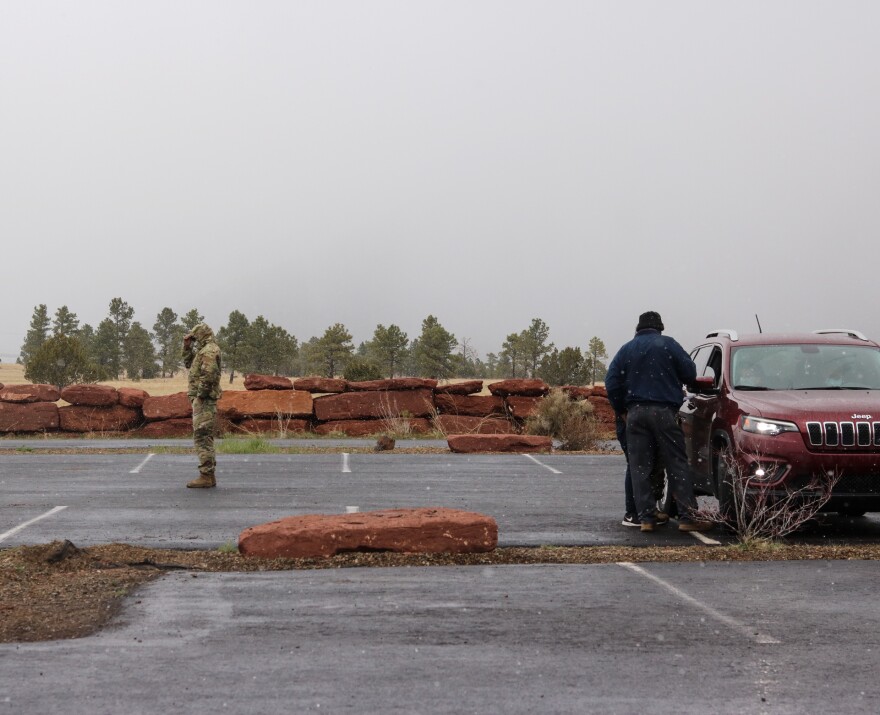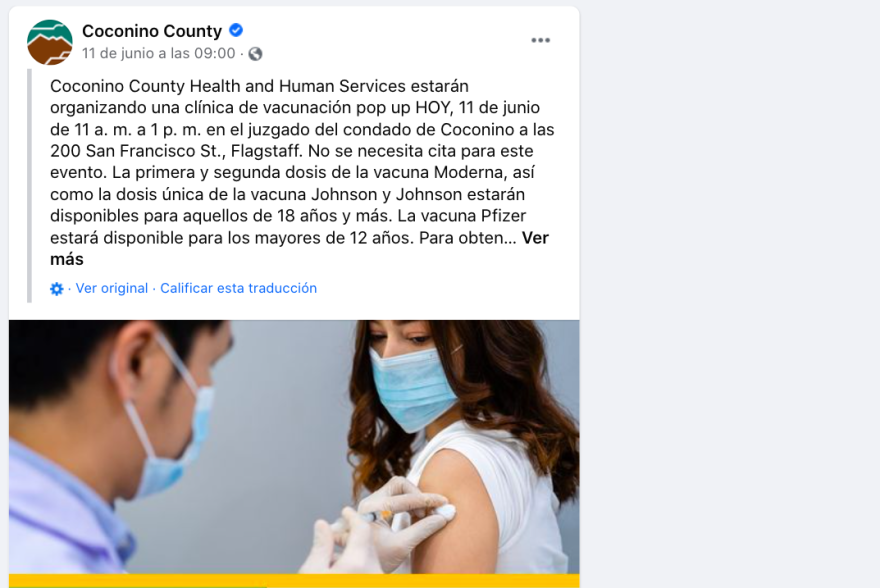Spanish is the second most commonly spoken language in the country next to English. In Arizona, translations can be found everywhere — from ATMs and voting materials, to signs at national parks.
But when it comes to information about the COVID-19 pandemic, multilingual resources haven’t always been readily available. Medical experts say unclear communication can lead to difficulties in receiving proper health care.
KNAU spoke with some of the people working to bring public health information to Spanish-speaking community members.
An Interactive Vaccination Experience: ‘That’s Everything’
Earlier this spring, volunteers gathered outside the San Francisco de Asis Church in Flagstaff to help administer the Moderna COVID-19 vaccine.
“How’s everyone feeling?” Roxanna Cardiel De Niz called to the crowd, receiving shouts and cheers in return.

Cardiel De Niz, a medical interpreter and organizer with the Northern Arizona Interfaith Council, had gathered volunteers to assist in the clinic.
It’s one of many pop-up clinics happening in the county. But this particular event — a joint effort from NAIC, the church, and Coconino County — was designed to reach Spanish speakers specifically.
During the clinic, Cardiel De Niz darts around, speaking both English and Spanish, as patients drive up and get their shots.
Volunteer Nellie Navarro says it’s important to help support her community: through her, patients can chat with someone in Spanish about the vaccine.
“I feel very satisfied to be here, to be able to help other people reach this step,” she says.
They can ask about side effects and be prepared if they get a fever, or a sore arm, Navarro explains. They won’t have to worry about navigating language barriers.
As he watches the drive-thru clinic unfold, County Supervisor Jeronimo Vasquez says having an interactive experience like this is invaluable.
“For a Spanish speaker, that's everything,” he says. “If you were an American in Mexico, and you had to go do your vaccination ... how much better would you feel if they spoke to you in English?”

Rolling Out Information: Delays And Improvements
Many Arizona counties offer Spanish-language information about the virus. But during the pandemic, there were delays statewide when it came to providing translated materials.
For example, the Arizona Department of Health Services didn’t offer online vaccine registration in Spanish until February — two months after the state’s vaccine website launched.
“Initially when vaccination clinics were happening, people were not able to access the ... clinics because they couldn't register,” Vasquez says. “My parents had a hard time getting online, and registering for vaccination.”
Coconino County offers Spanish language services for callers with questions about COVID-19. However, the hotline's automatic list of menu options didn't initially mention the resource to callers. County officials spotted the error and fixed it in March.
Now, when callers dial the line, they’re greeted by a calm, automated voice. “Para información en español, por favor marque número cuatro,” it says — for information in Spanish, please dial four.
A Disproportionate Impact
Dr. Jaime Fatás-Cabeza, a medical interpreter and professor at the University of Arizona, thinks there’s room for improvement statewide.
“We really need to bring regulation, standardization and compliance into the provision of language access,” he says.
Fatás-Cabeza believes healthcare facilities should employ certified interpreters — rather than volunteers. Interpretation, he says, is a heavy task to give someone who’s not necessarily trained in medical terminology.
Technically, many healthcare providers are legally obligated to offer that resource. Under the Affordable Care Act, healthcare institutions that receive federal funding are required to provide “meaningful access to individuals with limited English proficiency.”
That doesn’t always happen. Fatás-Cabeza says when he went to get his vaccine in Tucson, he looked for Spanish-language materials:
“There was no basic literature explaining the rules and procedures, the safety measures, the side effects and so on,” he recounts.
Not providing those services can lead to harmful, even fatal outcomes.
A recent study out of Brigham and Women’s Hospital in Boston found that patients who mainly spoke Spanish were 35% more likely to die from COVID-19. Researchers at the University of Southern California found Latino immigrants were more than 11 times more likelyto die from the virus than some other groups.
Navigating Outreach
“They are a community that has been disproportionately impacted by the pandemic,” says Stephanie Parra, executive director of the Phoenix-based non-profit ALL In Education.
Parra stresses the importance of multimedia outreach. Some community members, she says, don’t necessarily have an email address — or they’re more likely to be reached on WhatsApp.
To spread information during the pandemic, All In Education held phone banks, virtual town halls, and even collaborated with Univision — the country’s most popular Spanish-language television station.
Parra, who’s from the border town of Yuma, says her own experience allows her to coordinate Spanish-language outreach.
“I grew up on Univision,” says Parra. “That's all my parents watch. It is a trusted source of information.”

In Coconino County, Health and Human Services Director Kim Musselman says officials are navigating new ways to reach Spanish speakers.
“Our goal is to have everyone vaccinated who is able to get vaccinated,” Musselman told KNAU earlier this spring.
Musselman says the county started publishing Facebook posts with vaccine information — because the social networking site automatically translates text into the users’ preferred language.
Daniel Roberto Serpas, a Spanish professor at Northern Arizona University, says social media can be helpful for local governments spreading information, due to those automatic translation features.
“The translation is fairly good, you know?” says Serpas. “There shouldn't be any problems understanding, for a monolingual person.”

A Long-Term Effort
In neighboring Yavapai County, the region’s only Spanish-language newspaper is also confronting the virus with information. Rosanna Feyerabend is the editor-in-chief of Alianza Spanish News — a paper that has circulated in the county since 2006.
“All of the information comes from official sources,” Feyerabend says, listing Yavapai County Community Health Services and the Arizona Department of Health Services among others.
The newspaper took on a new role in the pandemic, says Feyerabend, who tries to connect with readers as much as possible through news articles and social media.
After Feyerabend got the vaccine, she even posted a photo of herself, band-aid on her arm, and wrote about the experience — to show people in her community it was safe.
“Enough people know me, and I did it as a form of promotion,” Feyeraband explains.
And, she says, “I think information saves lives.”




